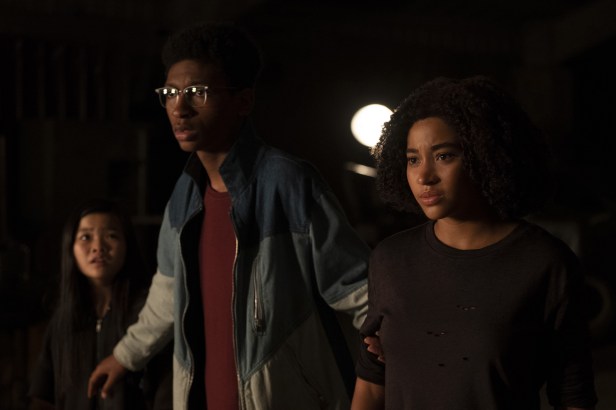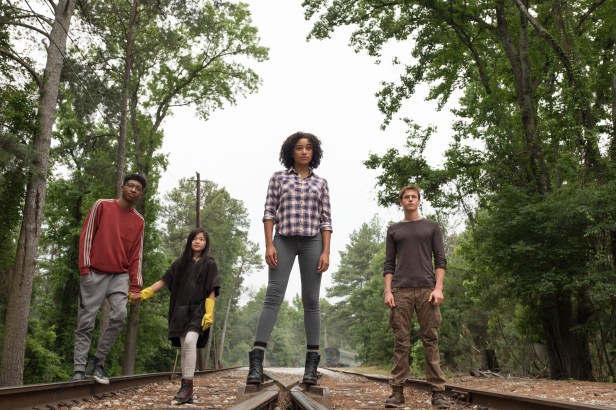The Darkest Minds (2018)
If you’re one of us, come find us.
I was so not keen for The Darkest Minds, the latest big-screen adaptation of yet another popular YA sci-fi/ thriller novel, the aforementioned book kicking off a series of three (rolls eyes). If the idea of a Darkest Minds movie trilogy wasn’t bad enough, the atrocious trailers, reminding me of a tweeny version of X-Men, did nothing to sway my opinion; nor did the flick’s relatively unknown cast, or that all-too-familiar ‘doom and gloom’ dystopian setting, both aiding to my rapidly growing concerns. Then the reviews came pouring in, verifying all my doubts and fears, critics calling the film dull, boring and uninspired, with many condemning it for its inability to distinguish itself in the already suffocated young-adult market. Needless to say, I avoided the media preview like the plague.
When I did finally manage to catch the darn thing, going in with lowered expectations, I found myself pleasantly surprised. Sure, The Darkest Minds is dreary and derivative, but its narrative, world-building and characters actually ain’t half bad (I kinda get why the novel is something of a phenomenon), the flick faring better than some of the other YA cruds we’ve been forced to endure — think the lame Twilight saga (which I only sat through because of KStew) or that god-awful Mortal Instruments (2013).

Based on the young-adult novel of the same name, written by New York Times bestselling author Alexandra Bracken, The Darkest Minds takes place in the not-so-distant future, in an unstable America, where a mysterious disease known as Idiopathic Adolescent Acute Neurodegeneration, or IAAN, has wiped out 98 percent of the population’s children, affecting those between the ages of 8 and 13 — mighty convenient, hey! The surviving 2 percent, however, found themselves gifted with psionic powers, quickly becoming enemies of the state, the country’s leader, President Gray (Bradley Whitford), placing these feared few in rehabilitation centers where they could be controlled and contained, alongside his very own son, Clancy (Patrick Gibson), who was constantly being tested upon by his father, desperate to find a cure.
Our story follows Ruby Daly, admirably played by Amandla Stenberg, whom we first meet on the night of her tenth birthday, this younger version portrayed by Lidya Jewett. After a near-perfect name day celebration, Ruby sneaks into her parents’ bedroom, finding them both fast asleep. Proceeding to rest beside them, Ruby touches her mother’s arm, which triggers some sort of voltaic reaction. When Ruby wakes the next morning and wanders down to the kitchen, she is shocked to discover that her mother, Molly (Golden Brooks), doesn’t remember who she is — if this scene were darker, or a tad scarier, it’d probably be nightmare fuel for pre-teens. Alarmed by this ‘stranger’ in her home, Molly locks the scared, confused Ruby in the garage, and then calls the authorities to come and take her away.

Immediately dispatched to the local treatment facility, named Thurmond, Ruby is tested for infection, her Color indicating which ‘mutant-like’ ability she’d developed. At Thurmond, the kids are segregated, divided into five factions (based on a no-longer-in-use color-coded Homeland Security Advisory System), which coincide with their level of threat. Those with the color Green were considered relatively safe, blessed with hyper-intelligence, i.e. enhanced mental and intellectual abilities; Blues were telekinetic and could move objects with their minds; while those that were colored Yellow (or Gold) had electrokinesis and were able to command and control electricity, and thus seen as a mild risk. The remaining two colors, while uncommon, were deemed extremely dangerous, and anyone categorized as either Orange or the lethal color of Red was to be exterminated or detained right away.
Much to Ruby’s dismay, she’s labeled as Orange, meaning she’d developed telepathy and was therefore able to read minds, influence thoughts and actions, and even erase and alter memories. But before the physician running the check has a chance to terminate her, Ruby uses her nifty mind control tricks to convince him otherwise, making the doc believe that she was, in fact, a Green. Luckily, Ruby is spared, spending the subsequent years living in secret amongst the Greens, Blues and Golds, with no other Reds or Oranges in sight.
Cut to six years later, Ruby now 16, and the incarcerated adolescents, surrounded by a platoon of heavily armed soldiers, are being tyrannized over by the merciless Captain McManus (Wade Williams), who runs the site like a wartime internment camp. You see, McManus had always had suspicions of Ruby’s ‘Green’ tag, who’s seen harassing the girl while she polishes boots in a room with dozens of fellow Greenies, the cruel commander knowing full well that a new subatomic frequency, able to detect those in the Orange class much easier, was about to be transmitted, making anyone who’d slipped through the cracks easier to expose.

KO’ed by this White Noise, Ruby rises to find herself in a medical lab, being examined by a seemingly warm and compassionate doctor named Cate (Mandy Moore), who warns Ruby of the immediate danger she was now in, McManus and his goons having uncovered her true classification. Thus, Cate promptly sneaks Ruby out of the facility, promising to take the terrified teenager to an opposing fringe asylum known as The Children’s League, where she’ll (presumably) be protected. Alas, the journey doesn’t go according to plan as, when Cate’s associate Rob (Mark O’Brien) arrives, and Ruby gets a glimpse into his not-so-innocent memories, she vamooses, teaming up with a bunch of other super-powered young’uns she bumps into at an abandoned gas station. Road-tripping through the (mostly) deserted America States, the group of rebel runaways (not trusting in The League) seek to locate an elusive Orange nicknamed ‘Slip Kid,’ believed to have evaded capture a record number of times, earning him the previously-mentioned moniker, this ‘legend’ rumored to be heading a safe haven for PSI children called East River. Ruby agrees to accompany the troop but on one condition, that they drop her back home along the way, our protagonist unwittingly setting out on (what will become) a life-altering expedition.
The Darkest Minds marks the first live-action picture helmed by Jennifer Yuh Nelson, who hails from the world of animation, the Korean-American moviemaker best known for directing Kung Fu Panda 2 and 3. While slow to start, The Darkest Minds is admittedly entertaining, despite being a bit of a Frankenstein’s Monster, made up of a hodgepodge of tired and fatigued science-fiction/ supernatural tropes and ideas. Militarizing mutants, for instance, has been milked in the X-Men franchise, whereas the apocalyptic landscape has featured prominently in many other YA series — The Hunger Games and The Maze Runner instantly spring to mind. And I guess we’ve seen gifted teens before, too, in shows like Netflix’s Stranger Things. For me, though, The Darkest Mind’s sheer complexity, and the out-there concept of a world with no children, really suckled me in, the storyline a little more involved than cynics would have you believe, exploring adult themes of self-sacrifice and government brutality whilst touching on the disturbing notion of raising a legion of young killers. Yeah, it’s bleak and depressing, but I can sorta see why adolescents — who may be fighting for peer acceptance, wanting to be taken seriously by their elders — are attracted to these types of quasi-pessimistic stories, stories that see young relatable heroes (struggling to make sense of the world around) search for a place to belong.

The screenplay penned by telly writer Chad Hodge is certainly competent, even if it’s probably a smidge too exposition-heavy (chiefly in its first act), and, at times, leaves audiences with too many lingering questions — is this pandemic only taking place in the USA or is it a worldwide thing? Are there still children being born, if so, what’s happening to them? And what of their parents? If I had a daughter whom I loved taken away from me, I wouldn’t sit by idly. Be that as it may, The Darkest Minds ticks all the obligatory boxes, delivering exactly what its YA demographic have come to expect, and a pinch more (just enough to stand out): ill-fated romance (check), a cast of identifiable characters (double check), and an unyielding adversary for our heroes to rally against (triple check), the flick’s antagonist taking the story to some intriguing, semi-unique places. With that in mind, Hodge’s writing can be a tad melodramatic, infusing the whole production with a small-screen feel, regardless of its often-credible visuals.
Just on that, filmmaker Yuh Nelson accomplishes a lot on a modest budget, the movie’s action moderately thrilling — think breakneck car chases, super-human advisories, and some large and looming, futuristic military choppers. The big set pieces are definitely passable and far superior to some of the crap we’ve seen in similar teen-centric movies. The VFX are nothing to sneeze at either, considering that The Darkest Minds isn’t a tentpole Marvel or DC property.

Made up of young photogenic up-and-comers (surprise, surprise), the cast is quite commendable, the sheer range of mixed-race stars rightfully reflecting the diversity of modern-day USA. Cali-born African-American Amandla Stenberg, Everything, Everything (2017), is solid as the flick’s anchor, Ruby, who’s fighting to overcome her crippling weaknesses and inadequacies. The support players give equally spirited, emotional turns, each crafting notable characters that viewers can empathize with. Love interest Liam Stewart is nicely played by Harris Dickinson, Beach Rats (2017), the dreamy ‘Blue’ hunk imbued with honesty and heart, while snarky brainiac ‘Chubs’ is nicely portrayed by African-American Skylan Brooks, Southpaw (2015), the dude adding some much-needed levity to proceedings; he sometimes works as the cluster’s voice of reason, too. The last of the kid fugitives — the mute electricity harnessing Suzume ‘Zu’ played by Asian-American youngster Miya Cech — leaves less of an impression, but she’s more memorable than Game of Thrones’ Gwendoline Christie, who has an awkward cameo as a ‘Tracer’ named Lady Jane, a bounty hunter type that subdues and fetches runaway tykes. Honestly, though, the highlight for me was seeing the lovely Mandy Moore, Tangled (2010), back on the silver screen, the singer-turned-actress shining as concerned practitioner Cate Begby.
Wrapping up with a big, brazen sequel hook, The Darkest Minds is a promising first chapter of a much larger story, the film’s closing montage hinting at some nifty narrative possibilities, our driven female heroine having finally embraced what makes her special. Shame that we’ll never get the proposed follow-up seeing as The Darkest Minds performed so poorly at the box office, earning a measly $35 million, globally. If this is indeed the case, as a stand-alone feature (an isolated experience running at a mere 104 minutes), The Darkest Minds winds up feeling like a colossal waste of everyone’s time!
3 / 5 – Good
Reviewed by S-Littner
The Darkest Minds is released through 20th Century Fox Australia